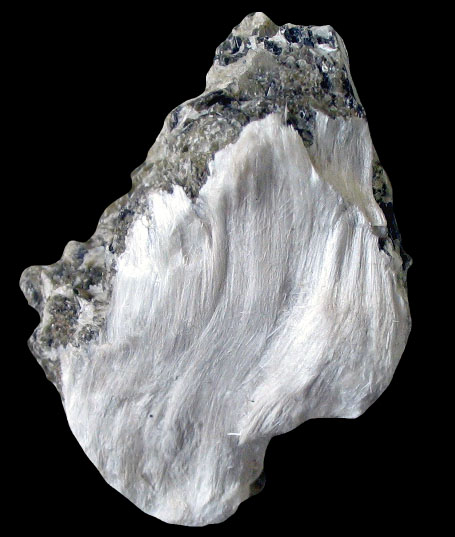Although asbestos is a naturally occurring mineral, it is very harmful to the human body, to the lungs and eyes especially. Without going into how asbestos leads to mesothelioma right away, I though I'd discuss a few of the types of asbestos first. There are six minerals are defined as "asbestos" including: chrysotile, amosite, crocidolite, tremolite, anthophyllite and actinolite:
Chrysotile commonly occurs as soft friable fibers. Asbestiform amphibole may also occur as soft friable fibers, but some varieties such as amosite are commonly straighter. All forms of asbestos are fibrillar, composed of fibers with widths less than 1 micrometre that occur in bundles and have very long lengths. Asbestos with particularly fine fibers is also referred to as "amianthus". Amphiboles such as tremolite have a sheetlike crystalline structure. Serpentine (chrysotile) has a stringlike crystalline structure. Tremolite often comtaminates chrysotile asbestos, thus creating an additional hazard.
Of these six minerals, there are 4 types of asbestos, white asbestos, brown asbestos, blue asbestos and other asbestos and they all are a contaminant of the human body. Most respirable asbestos fibers are invisible to the unaided human eye because their size is about 3.0-20.0 µm in length and can be as thin as 0.01 µm (human hair ranges in size from 17 to 181 µm in width.) Fibers ultimately form because when these minerals originally cooled and crystallized, they formed by the polymeric molecules lining up parallel with each other and forming oriented crystal lattices. These crystals thus have three cleavage planes, just as other minerals and gemstones have. But in asbestos, there are two cleavage planes that are much weaker than the third direction. When sufficient force is applied, they tend to break along their weakest directions, resulting in a linear fragmentation pattern and hence a fibrous form. This fracture process can keep occurring, and one larger asbestos fiber can ultimately become the source of hundreds of much thinner and smaller fibers.
As asbestos fibers get smaller and lighter, the become more easily airborne, and human respiratory exposures can result. Fibers will eventually settle but may be re-suspended by air currents or other movement.
Friability of a product containing asbestos means that it is so soft and weak in structure that it can be broken with simple finger crushing pressure. Friable materials are of the most initial concern because of their ease of damage. The forces or conditions of usage that come into intimate contact with most non-friable materials containing asbestos are substantially higher than finger pressure.
Asbestos exposure in the modern world is slowing down, however effects from the past are becoming more apparent. The third world is having difficulty ridding their cities of asbestos contaminated structures. With raised awareness, we can only make progress, even if it is a little at a time.
Tuesday, September 18, 2007
Asbestos leads to mesothelioma
Posted by
Consultant
at
11:43 PM
2
comments
![]()
Asbestos is a severe health hazard...
People may be exposed to asbestos in their workplace, their communities, or their homes. If products containing asbestos are disturbed, tiny asbestos fibers are released into the air. When asbestos fibers are breathed in, they may get trapped in the lungs and remain there for a long time. Over time, these fibers can accumulate and cause scarring and inflammation, which can affect breathing and lead to serious health problems.
Asbestos has been classified as a known human carcinogen (a substance that causes cancer) by the U.S. Department of Health and Human Services, the EPA, and the International Agency for Research on Cancer. Studies have shown that exposure to asbestos may increase the risk of lung cancer and mesothelioma (a relatively rare cancer of the thin membranes that line the chest and abdomen). Although rare, mesothelioma is the most common form of cancer associated with asbestos exposure. In addition to lung cancer and mesothelioma, some studies have suggested an association between asbestos exposure and gastrointestinal and colorectal cancers, as well as an elevated risk for cancers of the throat, kidney, esophagus, and gallbladder. However, the evidence is inconclusive.
Asbestos exposure may also increase the risk of asbestosis (a chronic lung disease that can cause shortness of breath, coughing, and permanent lung damage) and other nonmalignant lung and pleural disorders, including pleural plaques (changes in the membrane surrounding the lung), pleural thickening, and pleural effusions (abnormal collections of fluid between the thin layers of tissue lining the lung and the wall of the chest cavity). Although pleural plaques are not precursors to lung cancer, evidence suggests that people with pleural disease caused by asbestos exposure may be at increased risk for lung cancer.
www.beatmesothelioma.blogspot.com for more information.
Also, cancer.gov
Posted by
Consultant
at
12:59 AM
0
comments
![]()
What is Asbestos?

Asbestos is the name given to a group of minerals that occur naturally in the environment as bundles of fibers and can be separated into thin, durable threads. These fibers are resistant to heat, fire, and chemicals and do not conduct electricity. For these reasons, asbestos has been widely used in many industries.
There are two subgroups of asbestos: chrysotile, which has curly fibers and is in the serpentine family of minerals; and amphibole asbestos, which has straight, needle-like fibers and includes actinolite, tremolite, anthophyllite, crocidolite, and amosite asbestos. Chrysotile asbestos is the form that has been used predominantly in commercial applications worldwide.
For related information on mesothelioma, check out www.beatmesothelioma.blogspot.com
Posted by
Consultant
at
12:57 AM
0
comments
![]()